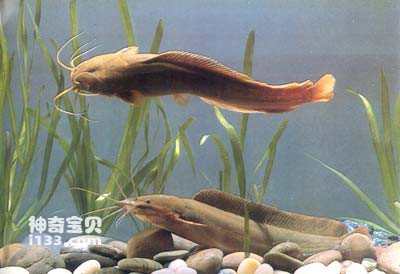Clarias batrachus belongs to the order Caturiformes, family Catharidae, and genus Clarias batrachus. Commonly known as: bearded catfish, pond louse, soil louse, pond angler fish. English name: Walking catfish.
The body is elongated, and the starting point of the dorsal fin gradually becomes flattened forward and laterally flattened backward. The head is broad, round, flat, with a straight ventral surface and an oblique back surface, wedge-shaped or plowshare-shaped. There are bony plates on the top of the head and both sides, covered with thin skin, and there are forehead fontanelles. Muzzle broad, blunt, and prominent. The lips are quite thick, the lip folds at the corners of the mouth are well developed, and the lip grooves are obvious. The mouth is wide, arc-shaped, slightly depressed, and the lower jaw is slightly shorter than the upper jaw. The teeth are small and dense, with villous tooth bands on the upper, lower jaw and vomer, and a crack in the middle of the lower jaw band. The head has 4 pairs of barbels; 1 pair of short nasal barbels, extending to the back of the gill opening; 1 pair of maxillary barbels and 2 pairs of maxillary barbels, both longer, extending to the base or rear of the pectoral fins. The eyes are quite small, with movable eyelids, and the distance between the eyes is very wide and flat. There are two nostrils on each side; the two nostrils are far apart, and the front nostril is a short tube, close to the snout. The gill openings are wide, and the gill cavity has a branch-like auxiliary respiratory organ composed of the fleshy protrusions of the second and fourth branchial arches, which can use oxygen in the air for gas exchange. The body is smooth and scaleless, with straight lateral lines. 1 dorsal fin, with a very long base, accounting for about 2/3 of the body length, without spines, starting at the top of the center between the starting points of the pectoral and pelvic fins, and the rear fins extend to the base of the caudal fin; the anal fin is the same shape as the dorsal fin and shorter than the dorsal fin; the pectoral fin Small, round, with hard spines; the pelvic fin is small, the caudal fin is round, and is not connected to the dorsal fin and anal fin. The body is brown-black, and each fin is gray-black.

Catfish is a tropical and subtropical freshwater fish with poor cold tolerance and will die when the temperature is below 6°C. Inhabits dark places and caves in rivers, ponds, ditches with lush aquatic plants, rice fields and swamps. There is an auxiliary respirator in the gill cavity, so it can withstand drought; it can live for a period of time in mud or places with little water; it can live in caves in dry seasons and survive for several months. They come out of their dens at night to hunt for food. They are active and like to live in groups. They often live together in ditches and caves with dozens to hundreds of them. They enter rivers or spend the winter in caves. They like to eat small fish, shrimps, aquatic insects and aquatic plants; young fish feed on plankton. In April, it enters ditches, rice fields and swamp areas from overwintering areas; between April and May, it digs a round nest and reproduces in the nest. After the eggs are fertilized, the male fish leaves and the female fish guards the cave to defend against enemies until the larvae are able to swim for food before leaving. Each time they lay 70-200 eggs, the egg-laying period occurs twice a year, in April-May and August-September. When the water temperature rises in summer, catfish return from the rice fields to rivers and ditches, and then swim to the rice fields to reproduce in August and September.
Distributed in various water bodies in the middle and lower reaches of the Yangtze River and in various provinces and regions south of the Yangtze River.
Catfish is widely distributed and is a cultured fish in the south; it is also a common small and medium-sized edible fish. After 5 months of breeding, the weight can reach about 250 grams. Its meat is tender, delicious and has high nutritional value. In addition to being eaten, it is also a medicinal fish and has always been regarded as a nourishing food. Whole fish has the effects of nourishing blood, tonifying deficiency, nourishing the kidneys, regulating the body, and supporting yang. It is commonly used among the people to nourish the body of patients with poor diet or pregnant women. It is mainly used as medicine to treat malaria, which does not heal after prolonged exposure; soreness of waist and knees; physical weakness; jaundice, chronic hepatitis; malnutrition in children; epistaxis, nosebleeds that stop sometimes and last for a long time; deficiency-fire syndrome (dizziness, palpitations, bleeding, dry mouth, Fever, irritability, insomnia in the soles of hands and feet); eating after surgery can promote wound healing. Foreign trade departments often regard this fish as one of the export aquatic products.
Be especially careful when catching catfish. Its pectoral fin spines are covered by a membrane containing venom gland tissue. There will be severe pain after being stabbed, but there will be no redness or swelling.
There is only one species of Catfish in the family Catharidae in my country. In recent years, relevant departments have introduced two other species from abroad and have succeeded in artificial breeding, becoming new breeding species in southern my country.
animal tags:
We created this article in conjunction with AI technology, then made sure it was fact-checked and edited by a Animals Top editor.